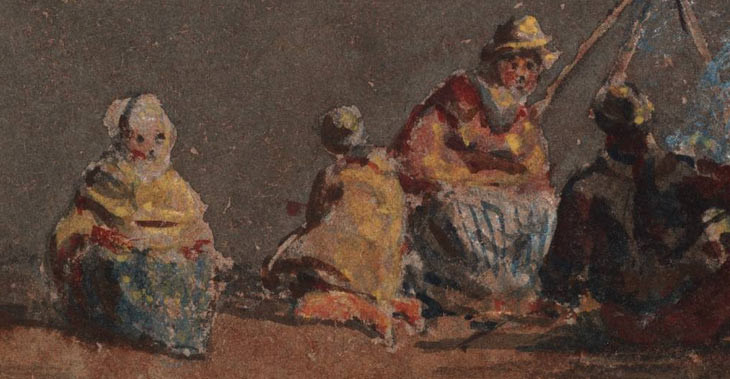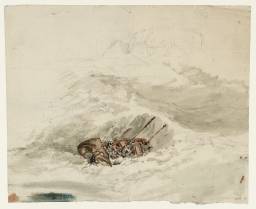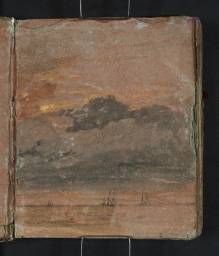‘Studies near Brighton’ and ‘Wilson’ Sketchbooks and Related Works 1796–7
From the entry
1796 was a watershed year: for the first time Turner showed an oil painting at the Royal Academy’s exhibition. This was Fishermen at Sea, a scene at night off the coast, deliberately chosen to display virtuoso depictions of moonlight, lantern-light, and glistening water (Tate T01585). It is unlikely that the little Moonlight, a Study at Millbank that he exhibited the following year (Tate N00459) was done afterwards: it has the aspect of a trial, a preliminary testing of his powers in oil, which he was prepared to show in public once he had established his credentials with Fishermen at Sea. In both works the handling rivals, as he surely intended, two masters of the nocturne: the Englishman Joseph Wright of Derby (1734–1797) and the Frenchman Claude-Joseph Vernet (1714–1789). We should expect some of the sketchbooks of this period to reflect his thoughts on the adoption of an important new medium, and challenging subject matter. The Wilson book documents the process fairly thoroughly ...
Studies near Brighton Sketchbook 1796
D00730–D00764, D00766–D00768, D00770–D00831, D00833–D00842, D40759–D40761
Turner Bequest XXX 1–96a
D00730–D00764, D00766–D00768, D00770–D00831, D00833–D00842, D40759–D40761
Turner Bequest XXX 1–96a
1796 was a watershed year: for the first time Turner showed an oil painting at the Royal Academy’s exhibition. This was Fishermen at Sea, a scene at night off the coast, deliberately chosen to display virtuoso depictions of moonlight, lantern-light, and glistening water (Tate T01585).1 It is unlikely that the little Moonlight, a Study at Millbank that he exhibited the following year (Tate N00459)2 was done afterwards: it has the aspect of a trial, a preliminary testing of his powers in oil, which he was prepared to show in public once he had established his credentials with Fishermen at Sea. In both works the handling rivals, as he surely intended, two masters of the nocturne: the Englishman Joseph Wright of Derby (1734–1797) and the Frenchman Claude-Joseph Vernet (1714–1789).
We should expect some of the sketchbooks of this period to reflect his thoughts on the adoption of an important new medium, and challenging subject matter. The Wilson book documents the process fairly thoroughly, from copying admired masters – Vernet himself and Richard Wilson (1713–1782) – to experimenting with dramatic effects of light at different times of day and night, and interior scenes: there is a sequence of church interiors that chimes with a group of watercolours exhibited at this time showing the interiors of ecclesiastical buildings: St Erasmus in Bishop Islip’s Chapel, Westminster Abbey, 1796 (British Museum, London);3 Transept and Choir of Ely Minster, ?1796 (private collection);4 Ely Cathedral, South Transept, ?1797 (Aberdeen Art Gallery);5 and Transept of Ewenny Priory, Glamorganshire, 1797 (National Museum Wales, Cardiff).6
How to cite
Andrew Wilton, ‘‘Studies near Brighton’ and ‘Wilson’ Sketchbooks and Related Works 1796–7’, August 2013, in David Blayney Brown (ed.), J.M.W. Turner: Sketchbooks, Drawings and Watercolours, Tate Research Publication, November 2014, https://www




